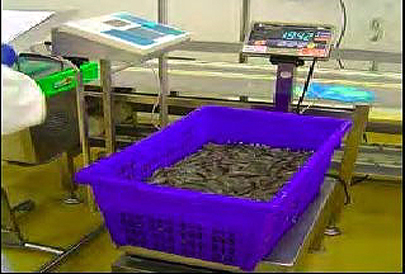Two Thai shrimp exporters are using an RFID system to improve their ability to quickly and accurately trace the shrimp they sell, from the time the product arrives at processing plants, until it is exported to customers in Japan, European countries and the United States. The companies are employing the technology to reduce labor costs by replacing manual, paper-based shrimp-tracking systems with automated, electronic ones. Additionally, RFID will enable the firms to speed and improve their ability to trace the food’s origin, processing and expiry data in the event of a product recall. The companies believe the technology will provide its customers—and, ultimately, consumers—confidence in the freshness of their products.
The two companies are Chanthaburi Frozen Food and Charoen Pokphand Foods. Part of the PTN Group conglomerate of large frozen-seafood export businesses, Chanthaburi is one of Thailand’s largest exporters of shrimp, which is a major source of revenue for that country. Charoen Pokphand Foods is a family-owned agribusiness company that also maintains retail and telecommunications holdings.
Both companies worked with IE Technology, a Thai RFID application developer and systems integrator, to design and deploy the systems. Forty readers and 4,000 plastic totes with embedded RFID tags are used at each site, though business processes differ somewhat from one plant to the other. The tags and readers operate at low frequency (134.2 kHz) and are compliant with the ISO 11785 air-interface protocol for tags used in livestock and other animal-tracking applications. The chips can hold up to 1024 bits of data, says Apiwat Thongprasert, a consultant with IE Technology’s business-development division, and are manufactured by Thai chipmaker Silicon Craft Technology.
The steps workers follow vary between the plants, where raw shrimp product can be turned into hundreds of different end products—some to be shipped as cooked goods, others to be sent out fresh and frozen. At the Charoen Pokphand plant, which processes an average of approximately 30 tons of shrimp per day, the totes are encoded and tracked only through raw shrimp processes. These include the receipt of raw seafood, washing, initial sizing (with the head attached), de-heading, secondary sizing of the headless shrimp, peeling, cutting, dipping and soaking, and freezing. At Chanthaburi, the shrimp are tracked through the raw and cooked stages, but only 80 percent of the average 40 tons of shrimp the plant processes are currently tracked with RFID.
At both plants, workers encode basic information to the tote tags as the shrimp is first received at the processing plant. This data includes a code indicating the shrimp’s type and farm of origin, as well as size and other data. To encode the information to the tags, and also to read the tags, workers use a large handheld computer with an integrated RFID reader, developed by IE Technology.
Each group of shrimp does not remain together in the same tote throughout the various processing steps. The animals are grouped by size and other factors, but before a worker moves any shrimp from one tote to another, the first tote’s tag is read. That data is then sent to the back-end software, where it is correlated with the tag ID of the tote to which the shrimp is being transferred. This process makes it impossible to determine where each individual shrimp in a tote at the end of the processing line comes from. However, the fish companies keep a manifest of all farms from which a group of shrimp was derived. Employees can also trace the date and time at which the shrimp entered the processing system. All of these data points were previously collected manually.
Middleware created by IE Technology controls all data encoded to the tags. It also collects and processes the read events, sending the appropriate data to Web-based software developed by the FXA Group, a food-industry software firm. Both plants utilize this software to track food products through processing and transportation. This data can later be shared with the fish company’s customers or customs officials.
The companies began testing the technology in December 2005, Thongprasert says, then rolled out the tracking system on a permanent basis in March of this year. The projects were partially funded by Thailand’s National Innovation Agency. IE Technology and the FXA Group covered the costs of their own product development related to the project.
The total budget to RFID-enable the two sites was $14.6 million baht ($476,306), Thongprasert notes, adding that both companies are pleased with the systems. Charoen Pokphand, Thongprasert says, is interested in expanding the system to record the productivity of individual workers, as well as analyze the efficiency of its shrimp-processing steps.
In addition, Thongprasert states, a number of other food manufacturers and exporters in Thailand have expressed interest in deploying similar systems. IE Technology is currently working with a grower of asparagus to track the produce from its point of harvest, through transportation and to a retailer.


